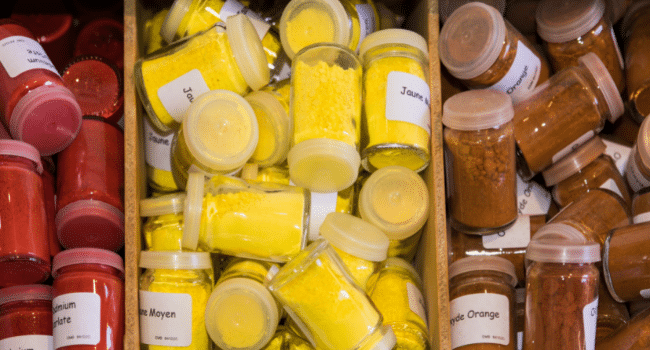While dyes and pigments may be interchangeably used terms, they have a few nuanced differences. Dyes are colorants that give color to a substrate by means of selective light absorption. Soluble in nature, they go through an application process that changes their crystal structure for a short period of time. This change takes place through absorption, solution, and mechanical retention or through the formation of covalent bonds.
Natural dyes are mostly used for color in decorative, aesthetic, or identification purposes. The actual use of dyes begins when they are dissolved in an aqueous solution.
There are different kinds of dyes or dyestuffs. Both artificial and natural dyes are used in the industry. You will mostly find dyes that contain solvent, reactive, acid direct, and sulphur in the market. Different dyes are chosen for varying needs of companies.
Coloring fibre is the major application of dyes. They are required to impart color to the ink, color concentrate, detergent, soap, and oils. Other more complex uses include color photography, antiseptics, history staining, and microscopic cell morphology.
The application and chemistry of each type of dye can create a range of colors, and for this customer requirements need to be ascertained well in time.
As per reputed color pigment manufacturers, pigments are defined as the black, white, or fluorescent particulate solids that are insoluble in nature. Another difference they have from dyes is that they remain unchanged by the substrate they are mixed with.
The appearance of dyes and pigments can be modified using scattering of light.
Pigments also maintain their crystal structure during the process of coloration. They are of various types including: organic, inorganic, natural, and synthetic.
Organic color pigments have a wider spectrum when it comes to color. They also have brighter colors, higher color strength, and are more resistant to acids and bases. Another advantage of organic pigments is their low toxicity.
Inorganic color pigments are classified as titanium dioxide, carbon black, and iron oxides and come with their own strengths. They are heat resistant, very durable, have better solvent resistance, and are economical.
Let us take a closer look at how dyes and pigments are different.
1 .Solubility
Natural pigments are insoluble in most solvents, whereas dyes mix well with water and other solvents. Pigments are dropped in a binder to make them soluble.
2. Size
The particle size of natural pigments is larger than dyes. The difference can be understood as a dye being a pinhead and a pigment being a football.
3. Lightfastness
Dyes have a quicker reaction to light compared to pigments. Dyes are more prone to fading when exposed to light and pigments are more resistant.
4. Bonding
Pigments require a carrier or medium to help them become soluble. The carrier acts as a glue to help pigments attach themselves to the substrate. Dyes don’t require a medium or carrier and can directly form aqueous solutions.
5. Stability
Pigments have an edge over dyes here. They also have a longer life.
These differences should help you decide which colorant you want to pick for your next application.
